
Bit-tech – So is it fair to say you prefer small formfactor cases in general?
Justin – I think so. The original acrylic PC case I ordered was small too but as Shaun says, it’s also a lot to do with smaller cases being easier to manufacture, at least with a CNC and acrylic anyway.
Bit-tech – Was acrylic always the material of choice?
Justin - We actually started out using wood, but this wasn’t when we were making PCs. We decided on acrylic as it’s available in lots of different colours and is easy to machine, although we use metal sheets for some components in our current cases and are toying with making metal panels too although it’s not as nice to work with.
Bit-tech - What type of acrylic do you use?
Shaun - We started with the usual glossy stuff but we found that this scratches really easily, especially black, and it also attracts dust really badly – not what you want with a PC.
Justin – We then moved on to a matt coated acrylic where only the inside was glossy but this still attracted dust. In the end we did a lot of searching and found the supplier that we use today. It’s got a slightly matt finish, is really strong, easy to work with and is statically discharged so dust isn’t an issue.
Bit-tech – yes we’ve noticed it has a certain lustre to it – it’s strangely nice to touch! So are there any specific materials or tools you use?
Shaun – We obviously use the special acrylic and also the cube corner braces, which are made from brass – others we’ve seen are made from aluminium and these are too soft in our opinion. It’s easy to strip the threads.
Justin - We actually started using the brass ones but couldn’t find anywhere that sold them with enough screw threads to secure a corner section-worth of panels together which was odd. We had to tap them by hand, which is obviously difficult to do.
Shaun – I dread to think how many we tapped – we sold a lot of cases like this so it was probably hundreds. Thankfully they ship with the extra hole now.
Justin – Apart from these, we also use aluminium for the rear PCI slots, which we’ve recently started to powder coat rather than shipping as a bare metal piece. We tried just painting these outselves but it was tricky to get good finishes all the time and standard spray paint is prone to scratching.
Shaun – As far as the tools go, we initially made the cases on a third party CNC and finished them off by hand. We then bought a £6,000 CNC, which we still own, but this has quite a small bed and manual tool switching. It worked but was quite labour intensive.
Justin – The big one downstairs we’ve had for a while and the automatic tool switching saved so much time. It’s pretty much the case now that we can set it running and come back an hour later with the job done. The compressor it has sucks the acrylic to the bed to stop it moving and extracts waste dust too plus it generates a fair amount of heat which we use to warm the whole unit in the winter. Speaking of being green, most of our waste acrylic is recycled too.
Justin – I think so. The original acrylic PC case I ordered was small too but as Shaun says, it’s also a lot to do with smaller cases being easier to manufacture, at least with a CNC and acrylic anyway.
Unlike the previous CNC, the new model can deal with much larger pieces of acrylic, cutting down the time it takes to create each case - click to enlarge
Bit-tech – Was acrylic always the material of choice?
Justin - We actually started out using wood, but this wasn’t when we were making PCs. We decided on acrylic as it’s available in lots of different colours and is easy to machine, although we use metal sheets for some components in our current cases and are toying with making metal panels too although it’s not as nice to work with.
Custom PC Magazine hall of fame - L3p Parvum, Magnus and something the author knocked together. Right - some sponsored hardware already allocated to new eye-candy filled projects - click to enlarge
Bit-tech - What type of acrylic do you use?
Shaun - We started with the usual glossy stuff but we found that this scratches really easily, especially black, and it also attracts dust really badly – not what you want with a PC.
Justin – We then moved on to a matt coated acrylic where only the inside was glossy but this still attracted dust. In the end we did a lot of searching and found the supplier that we use today. It’s got a slightly matt finish, is really strong, easy to work with and is statically discharged so dust isn’t an issue.
Parvum's first retail mini-ITX case. It will ship with Parvum fans too - click to enlarge
Bit-tech – yes we’ve noticed it has a certain lustre to it – it’s strangely nice to touch! So are there any specific materials or tools you use?
Shaun – We obviously use the special acrylic and also the cube corner braces, which are made from brass – others we’ve seen are made from aluminium and these are too soft in our opinion. It’s easy to strip the threads.
Justin - We actually started using the brass ones but couldn’t find anywhere that sold them with enough screw threads to secure a corner section-worth of panels together which was odd. We had to tap them by hand, which is obviously difficult to do.
Shaun – I dread to think how many we tapped – we sold a lot of cases like this so it was probably hundreds. Thankfully they ship with the extra hole now.
Justin – Apart from these, we also use aluminium for the rear PCI slots, which we’ve recently started to powder coat rather than shipping as a bare metal piece. We tried just painting these outselves but it was tricky to get good finishes all the time and standard spray paint is prone to scratching.
Shaun – As far as the tools go, we initially made the cases on a third party CNC and finished them off by hand. We then bought a £6,000 CNC, which we still own, but this has quite a small bed and manual tool switching. It worked but was quite labour intensive.
Justin – The big one downstairs we’ve had for a while and the automatic tool switching saved so much time. It’s pretty much the case now that we can set it running and come back an hour later with the job done. The compressor it has sucks the acrylic to the bed to stop it moving and extracts waste dust too plus it generates a fair amount of heat which we use to warm the whole unit in the winter. Speaking of being green, most of our waste acrylic is recycled too.
New mini-ITX case - click to enlarge

MSI MPG Velox 100R Chassis Review
October 14 2021 | 15:04


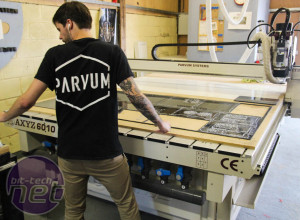
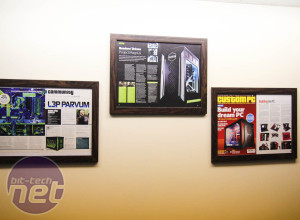
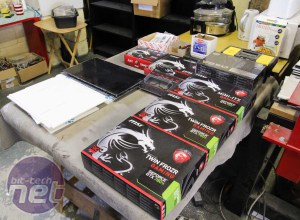
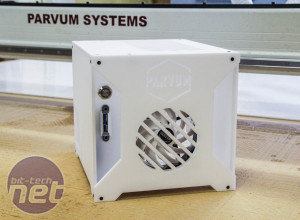
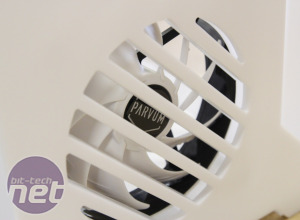
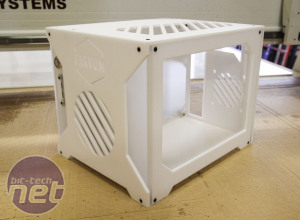
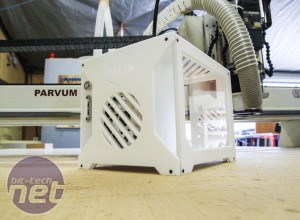







Want to comment? Please log in.